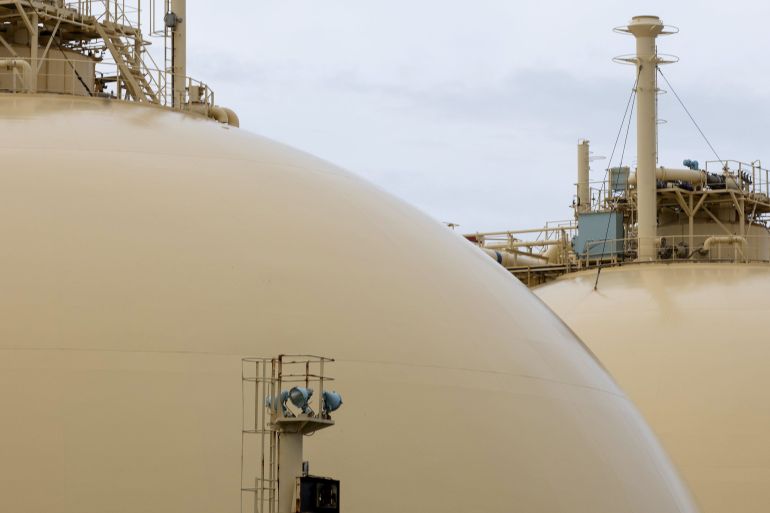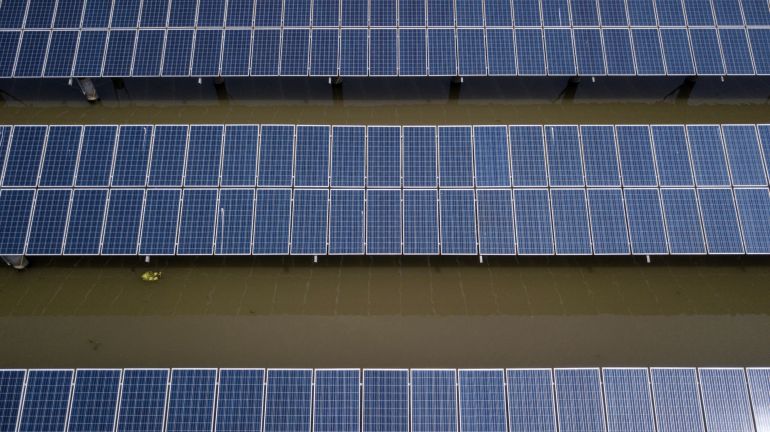Australia looks to fill Asia’s energy gap amid Ukraine crisis
Australia is seeing increased demand for its LNG and coal as war and sanctions upend energy supplies.

Taipei, Taiwan – As the Ukraine war upends global commodity markets and triggers a scramble for resources, the crisis is redrawing the Asia-Pacific region’s energy map. While the picture is far from clear, the region’s emerging contours are already having an outsized effect on the resource juggernaut of Australia.
With similar trade profiles, Russia and Australia compete in many key markets, from gas and coal to wheat and barley, ideally positioning Canberra to fill the gap left by a sanctioned Kremlin.
Keep reading
list of 4 itemsCanada’s Trudeau says Putin responsible for ‘war crimes’
Will Hong Kong’s new leader further erode freedoms there?
Ukraine latest updates: UN rights body to discuss ‘Russia abuses’
Amid geopolitical uncertainties, many Asian markets have fallen back on the nearby, stable democracy to weather the storm.
Woodside, Australia’s largest exporter of liquefied natural gas (LNG), has reported soaring demand from democratic Asia. While American and Qatari LNG exports were redirected to Europe in March, Australia sent nine additional cargoes to South Korea and Japan and could yet gain more market share from Russia.
Meanwhile, the country’s coal miners have been scrambling to keep up with record demand, which has sent prices soaring. Newcastle coal futures, the commodity’s benchmark for Asia, rocketed to more than $400 per tonne in early March and currently remain about $350. Some producers reported in April that Australian coal sold out due to the rush.
“A lot of energy in Asia has been a-political,” Graeme Bethune, founder of EnergyQuest, an Australian-based energy advisory firm, told Al Jazeera. “But that is changing, as it is around the world. I think there will be more alignment between democracies going forward … and Australia is considered a safe and secure trading partner.”

Longer term, the outlook is less clear. Though Australia is valued as an energy backstop for the region now, the deeper trend for Asian nations is towards energy self-sufficiency, a trend likely to be accelerated by the current crisis.
Geopolitical pressures, combined with a new set of price incentives, could see an acceleration towards renewables, lowering reliance on imports and dampening demand for Australian energy.
“It would be nice to divorce energy from geopolitics, but the reality is you just can’t,” Bruce Robertson, an Australian analyst at energy think-tank IEEFA, told Al Jazeera.
“Ukraine has been a wake-up call for literally everyone around the world. Governments are looking at Europe, and Germany in particular, and seeing the new need for energy independence. If you can produce energy at home, you’re far more secure than relying on imports.”
Japan and China, two of the biggest buyers of Australian resources, are both looking to lower imports of its key energy products. A recent study by Australian National University academics warns China’s rising domestic production of coal means a huge cut to Australian imports is imminent, forecasting a 25 percent decrease by 2025.
The forecast follows on the heels of a bitter trade war that saw Australian coal targeted by unofficial sanctions by China. Although Australian coal that had been stranded at Chinese ports resumed passing through customs again late last year, the outlook suggests the commodity’s best days in China are already behind it.
Challenges to Australian exports
”China doesn’t want to rely on Australia for energy, that’s the bottom line,” Robertson said, predicting Beijing’s pivot away from Canberra will extend to LNG as well.
“They’ll likely stay the course with the current projects, but it is highly unlikely they will sign up for new LNG projects going forward.”
“China has not signed new LNG contracts with Australia for several years now,” Bethune added, noting more contracts had gone to US companies, while stressing he could not be sure how big a role politics had played.
Bethune said China still needs Australian coking coal for steelmaking and that will likely stay the case for the time being, despite an overall trend of diversifying away from Australian imports.
Japan is the world’s largest LNG importer and enjoys a longstanding trade partnership with Australia. Hit by shockwaves from Russia in recent weeks, increased shipments from Australia – already its largest supplier at more than 36 percent of total imports – helped Japan weather the storm. Yet Tokyo, which on Sunday announced it would phase out Russian oil in tandem with its Group of Seven partners, has set its sights on greater self-sufficiency, too.
“Japan aims to halve its LNG imports by 2030,” Robertson said. “Japan is the largest market for Australian LNG and represents around a third of our total exports. If Tokyo reaches its target, it would be a serious knock to Australian gas.”
While Australian LNG suppliers are looking to pivot to emerging South Asia, those markets present new obstacles.
Pakistan has experienced an LNG shortage marked by rolling blackouts and is now in contract disputes over defaulted projects with multinationals Gunvor and ENI. Bangladesh, meanwhile, has run out of credit to buy LNG at soaring spot market prices.
“I think they’ve been scared by the volatility and lack of availability [of gas],” Robertson said.
“Will they continue to double down on gas after this? I think it would be a rather foolish move.”

The once optimistic outlook for natural gas overall is increasingly in doubt as rising costs of LNG and market volatility have made renewables a lot more attractive.
“For price-sensitive countries, the current environment and volatility is certainly a cause of concern,” Kaushal Ramesh, a Singapore-based researcher at Rystad Energy, told Al Jazeera. “There is a risk countries will be unable to afford LNG for the next five years as Europe absorbs global supply.”
Ramesh said many countries will face the choice of either continuing to rely on coal and fuel oil or making the jump to renewables.
“Ultimately, one of the greatest means of ensuring energy security is to break the link with commodity imports altogether – from both this perspective and a marginal price perspective, renewables provide that pathway,” he said.
Despite Australia’s reliance on resources, there is still a bullish case to be made for its energy as the renewable era dawns.
Australia has the highest solar radiation per square metre of any continent on Earth, receiving roughly 58 million petajoules of sunshine each year – equivalent to 10,000 times its total energy consumption.
Efforts to leverage that power are under way. The Australia-Asia PowerLink project, expected to be completed later in the decade, will help power Singapore and Indonesia with the largest solar farm in the world in northern Australia.
“There’s also a growing focus on hydrogen,” Bethune said. “Australia also produces critical minerals needed for renewables.”
Ramesh said Australia is in a strong position to be a regional renewable energy powerhouse when it comes time to break the commodity link.
“We understand there are ongoing discussions about renewable power exports and the development of green hydrogen and green ammonia hubs,” he said.
One such plant for these new green fuels was granted “coordinated project status” by the Queensland state government just last month.
“These projects are still in their early stages, but they have attracted attention from Australia’s current fossil fuel customers in North Asia,” Ramesh said.